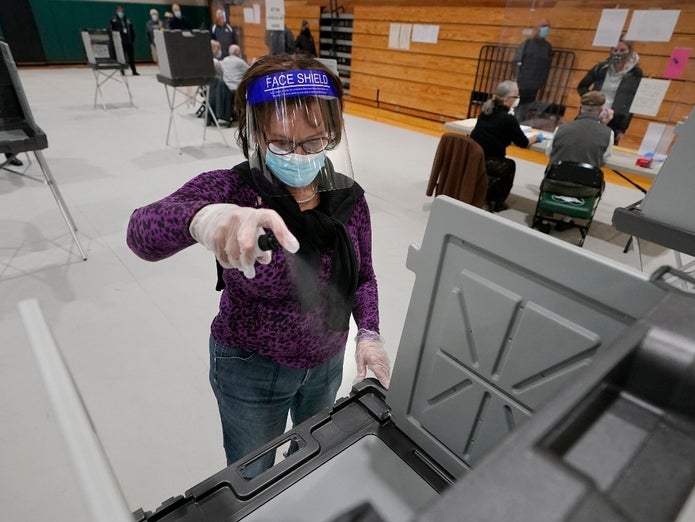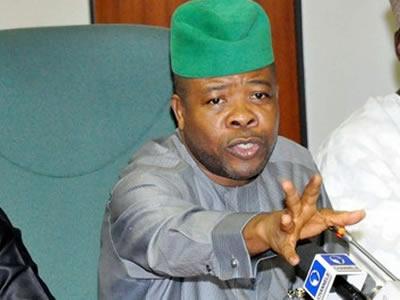ACROSS AMERICA — Poll workers across the U.S. cleaned and disinfected polling places Tuesday as voters headed out to cast Election Day ballots, even as cases of the coronavirus are on the rise across the country.
In some states, election workers are wiping down voting machines after each use. In others, officials have sent hundreds of thousands of pieces of personal protective equipment and social distancing markers to polling places.
People who are sick with the coronavirus or quarantined after an exposure cannot be denied the right to vote on Tuesday, making the need for masks and good hygiene imperative, according to the Centers for Disease Control and Prevention.
Voters were being reminded to maintain social distance and to bring a mask, tissues, hand sanitizer, water and a black ink pen with them to the polls. Preparing in advance and following health and safety protocols helps voters minimize their risk of catching the COVID-19 virus, health authorities said.
Rather than enforcing across-the-board mask mandates, most polling places in the country have settled on a strategy of strongly encouraging voters to wear masks. Their message is that abiding by widely accepted health guidelines will protect poll workers and other voters.Subscribe
“You can’t turn away somebody because they’re not wearing a mask,” Gabriel Sterling, statewide voting system implementation manager for the Georgia Secretary of State’s Office, told The Associated Press.
In a memo this week, White House coronavirus task force coordinator Dr. Deborah L. Birx called for “much more aggressive action” in fighting the virus. “We are entering the most concerning and most deadly phase of this pandemic … leading to increasing mortality,” Birx said.
The warning came as the U.S. reported just shy of 100,000 new cases on Friday and reached a seven-day average of over 85,500 cases on Monday.
Even as daily cases over the past two weeks nearly doubled what they were two weeks prior, several Republican governors across the country have taken a hands-off approach to managing the virus.
In recent days, governors in South Dakota, North Dakota, Tennessee and Alaska have emphasized personal responsibility while saying that state government should play little to no role in slowing the spread, the New York Times reports.
The laissez faire approach to dealing with the virus mirrors that of President Donald Trump, who attended five rallies on Monday to appeal to crowds of voters.
Speaking earlier in the week at a campaign rally in Opa-locka, Florida, Trump expressed frustration that the surging cases of the virus remains prominent in the news, sparking chants of “Fire Fauci” from his supporters.
“Don’t tell anybody, but let me wait until a little bit after the election,” Trump replied to thousands of supporters, adding he appreciated their “advice.”
But firing Fauci would not be as simple as letting go of a press secretary, the Washington Post reports. Because the doctor is employed by the National Institute of Allergy and Infectious Diseases, he cannot be fired or demoted for political reasons.
Instead, the president would have to navigate civil service protections and prove he has cause for Fauci’s dismissal. He would, unless pushback fails to stall Trump’s recent executive order that strips senior federal scientists, attorneys, regulators, public health experts and others of civil service protections.
Some view the move as an effort to replace career public health experts and scientists with political appointees. The order has been been criticized by both members of the Trump administration and several labor unions, Politico reports.
One study from Stanford University economists estimates at least 30,000 cases of the coronavirus and 700 deaths were the result of 18 of President Donald Trump’s in-person rallies held between June and September.
The numbers are based on a statistical model that compares coronavirus rates in the 18 counties where the rallies were held to 200 counties with similar demographics.
“The communities in which Trump rallies took place paid a high price in terms of disease and death,” the study’s findings read.
The study did not look at rallies by former Vice President Joe Biden, which have mostly been drive-in events or socially distant outdoor gatherings.
The Latest Numbers
At least 540 new coronavirus deaths and 93,581 new cases were reported in the United States on Monday, according to a New York Times database. Over the past week, there have been an average of 85,563 cases per day, an increase of 44 percent from the average two weeks earlier.
As of Tuesday, 36 states and Puerto Rico remained above the positive testing rate recommended by the World Health Organization to safely reopen. To safely reopen, the WHO recommends states remain at 5 percent or lower for at least 14 days.
More than 9.29 million people in the United States had tested positive for the coronavirus as of Tuesday morning, and more than 231,600 have died, according to a tally by Johns Hopkins University.
PEABODY, PATCH






